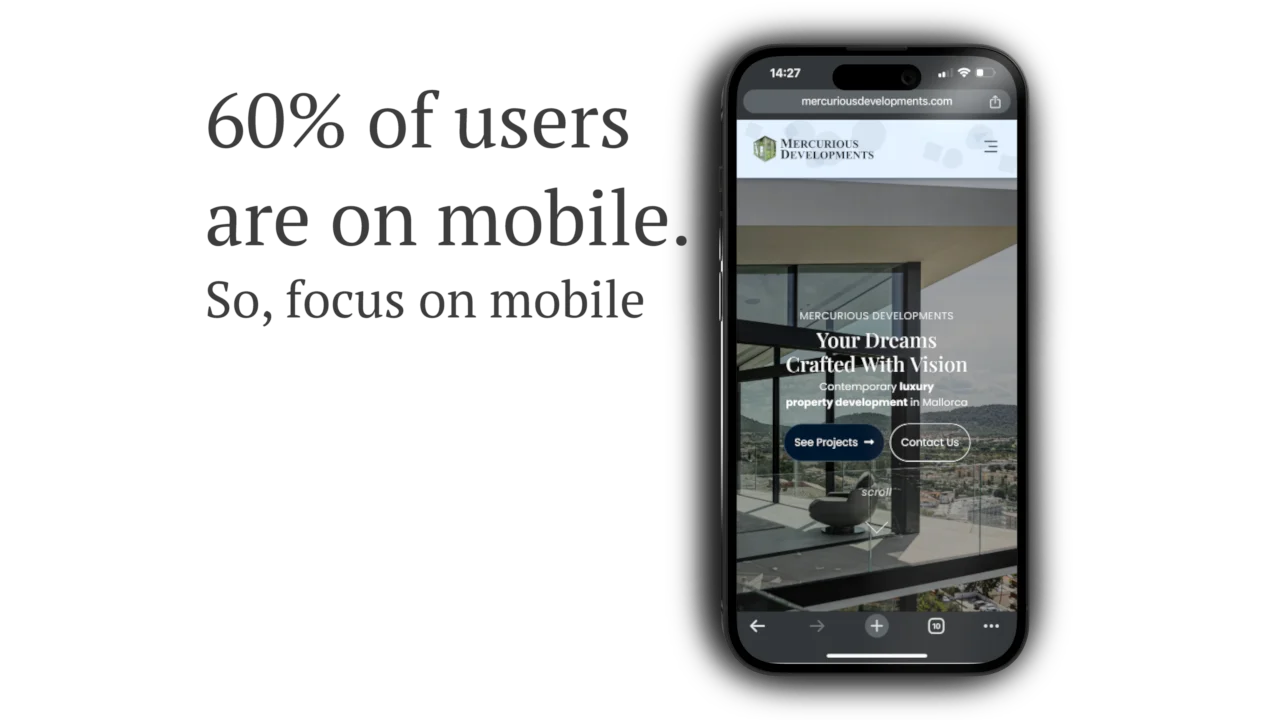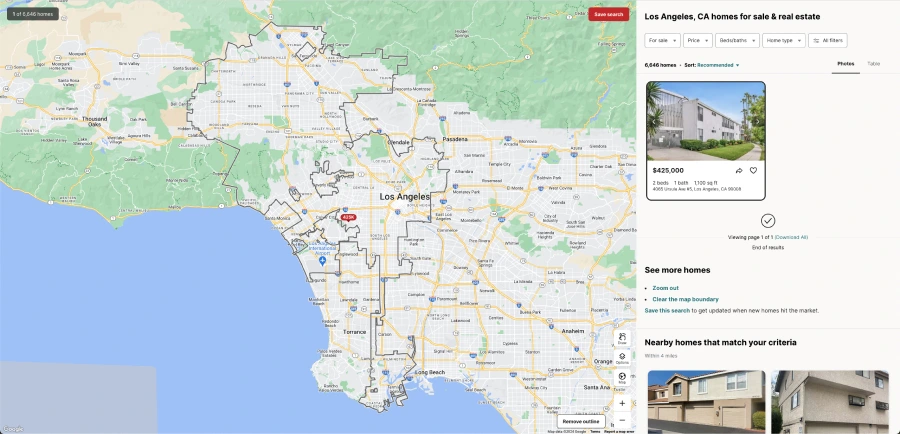Introduction
Real estate websites play a crucial role in the success of real estate businesses. They serve as the first point of contact for potential clients, providing information about available properties and helping users make informed decisions. this is why it is essential for real estate websites to stay ahead of the game by incorporating the latest design trends and marketing strategies.
The design of a website is the first thing your potential client will see, so it is important that it follows modern UI and UX trends. A well-designed website enhances the user experience, making it easy for users to navigate through property listings and find the information they are looking for. Mobile devices have become the primary source of internet access, so real estate websites need to have a mobile-first design approach to ensure compatibility across all devices.
Top 10 Real Estate Website Design Trends
Real estate website design trends are constantly evolving to meet the changing needs and expectations of users. Here are the top 10 trends that are shaping the industry today:
1. Immersive 3D Virtual Tours
One of the hottest trends in real estate website design is the incorporation of immersive 3D virtual tours. These tours allow users to virtually “walk” through properties and experience them as if they were physically there. This technology provides a more interactive and engaging experience for users, making property listings come to life. By offering virtual tours, real estate professionals can showcase their properties in a way that is both informative and visually appealing, enhancing the user experience and increasing the chances of attracting prospective clients.
2. AI and Personalization Features
Advancements in artificial intelligence (AI) have paved the way for personalized website experiences. Real estate websites can now utilize AI-driven technologies to curate property recommendations based on individual user behaviors. This level of personalization helps prospective clients find properties that align with their preferences and increases their engagement with the website. Chatbots and virtual assistants powered by AI also play a significant role in enhancing the user experience by providing round-the-clock assistance and making information access swift and efficient.
Key features of AI and personalization in real estate website design include:
- Machine learning algorithms that analyze user behavior and provide personalized property recommendations.
- Chatbots and virtual assistants that guide users and answer their queries in real-time.
- Personalized content based on user preferences, such as blog posts about local schools or home maintenance tips.
3. Mobile-First Design Approach
60% of users use mobile devices for internet access, real estate websites need to prioritize a mobile-first design approach. This means designing the website with mobile devices in mind and ensuring that it is fully responsive and optimized for mobile viewing. A mobile-first design approach involves:
- Streamlined and simplified navigation menus for easy browsing on small screens.
- Clear and easy-to-use search bars to help users find specific properties or information.
- Responsive layouts that adapt to different screen sizes and resolutions.
- Fast loading times to cater to users who are on the go and have limited data.
By adopting a mobile-first design approach, real estate websites can provide a seamless user experience across all devices and attract prospective clients who prefer to browse properties on their smartphones or tablets.

4. Minimalistic and Clean Design
Minimalistic and clean design has become a popular trend in real estate web design. This design approach focuses on simplicity, using clean lines, ample white space, and minimal clutter to create an aesthetically pleasing and easy-to-navigate website. A good example of this is lecollectionist.com. Benefits of a minimalistic and clean design include:
- Improved readability and focus on important elements such as property listings and call-to-action buttons.
- Enhanced user experience with a clear visual hierarchy and organized content.
- Faster loading times due to fewer design elements and reduced complexity.
- Increased brand credibility and professionalism.
Real estate websites that embrace minimalistic and clean design principles can create a visually appealing and user-friendly experience, making it easier for prospective clients to find the information they need and take action.
5. Dynamic and Interactive Maps
Interactive maps have become an essential feature in real estate website design. These maps allow users to explore properties and their surrounding areas, providing a comprehensive view of the location and amenities. Key benefits of incorporating dynamic and interactive maps in real estate websites include:
- Increased engagement and user interaction with the website.
- Improved user experience by providing a visual representation of property locations and nearby amenities.
- Enhanced property search functionality, allowing users to filter properties based on location and other criteria.
- Increased time spent on the website, as users explore the map and search for properties in their desired areas.

By integrating dynamic and interactive maps into their websites, real estate professionals can provide an immersive experience and help prospective clients find their dream properties more easily.
6. High-Quality Photography and Video Content
High-quality photography and video content are crucial elements in real estate website design. Visual content plays a significant role in attracting and engaging prospective clients and showcasing properties in the best possible light. Benefits of incorporating high-quality photography and video content include:
- Increased visual appeal and professionalism of the website.
- Enhanced user experience by providing a realistic representation of properties.
- Improved engagement and time spent on the website, as users view and interact with visual content.
- Increased chances of converting prospective clients into leads or customers.
Real estate professionals should invest in professional photography and videography services to capture the essence of their properties and create visually stunning content for their websites.
Convert your images into the next-gen format (WEBP) without losing quality ⇒
7. User-Friendly Navigation
User-friendly navigation is a fundamental aspect of real estate website design. A website with intuitive and easy-to-use navigation menus enhances the user experience and makes it easier for prospective clients to find the information they are looking for. Key elements of user-friendly navigation include:
- Clear and concise menu labels that are relevant to the content of the website.
- Logical organization of menu items to guide users along their desired journey.
- Search functionality that allows users to find specific properties or information quickly.
- Consistent navigation across all pages of the website.
By prioritizing user-friendly navigation, real estate professionals can create a seamless browsing experience and increase the chances of converting website visitors into leads or customers.
8. Integration of Social Proof Elements
Social proof plays a significant role in building trust and credibility in the real estate industry. Integration of social proof elements such as testimonials and reviews into real estate websites can enhance the user experience and increase the chances of converting prospective clients. Benefits of integrating social proof elements include:
- Increased trust and credibility in the brand and the services provided.
- Enhanced user experience with real-life experiences and recommendations from satisfied clients.
- Improved conversion rates as prospective clients are more likely to trust the recommendations of others.
Real estate professionals should showcase positive testimonials and reviews from satisfied clients on their websites to establish credibility and build trust with prospective clients.
9. Advanced Search Filters and Functionality
Advanced search filters and functionality are essential features in real estate website design. These features allow users to refine their property search based on specific criteria such as location, price range, number of bedrooms, and more. Benefits of incorporating advanced search filters and functionality include:
- Improved user experience by enabling users to find properties that meet their specific requirements.
- Increased engagement and time spent on the website as users explore different property search options.
- Enhanced property search functionality, making it easier for prospective clients to find their dream properties.
By providing advanced search filters and functionality, real estate websites can cater to the diverse needs of their prospective clients and increase the chances of conversions.
10. Sustainability and Green Design Elements
Sustainability and green design have become significant trends in the real estate industry. Real estate professionals are incorporating sustainability and green design elements into their websites to showcase their commitment to environmental responsibility. Benefits of incorporating sustainability and green design elements into real estate websites include:
- Increased appeal to environmentally-conscious buyers who prioritize sustainability.
- Enhanced brand image and reputation as a responsible and eco-friendly real estate professional.
- Improved user experience by providing information about sustainable features and initiatives.
Real estate professionals should highlight sustainability and green design elements in their websites to attract environmentally-conscious buyers and showcase their commitment to sustainability.

Enhancing UI/UX for Real Estate Websites
A seamless user interface (UI) and user experience (UX) are essential for real estate websites to attract and engage prospective clients. By focusing on enhancing the UI and UX, real estate professionals can create a website that is visually appealing, easy to navigate, and provides a seamless browsing experience. Key elements of enhancing UI/UX for real estate websites include simplifying the user journey and emphasizing responsive design to cater to users on different devices.
Simplifying the User Journey
Simplifying the user journey is a crucial aspect of enhancing UI/UX in real estate website design. A simplified user journey means that users can easily navigate through the website and find the information they are looking for. Key elements of simplifying the user journey include:
- Clear and intuitive navigation menus that guide users along their desired path.
- Well-organized content and property listings that are easy to browse and understand.
- Consistent design elements and visual cues that help users understand their current location on the website.
By simplifying the user journey, real estate websites can provide a seamless browsing experience and increase the chances of converting website visitors into leads or customers.
Emphasizing Responsive Design
Emphasizing responsive design is crucial for enhancing UI/UX in real estate website design. Responsive design ensures that the website is compatible and visually appealing across all devices, including desktops, laptops, smartphones, and tablets. Key elements of emphasizing responsive design include:
- User-friendly layouts that adapt to different screen sizes and resolutions.
- Clear and readable content that is legible on small screens.
- Optimized images and videos for faster loading times on mobile devices.
By emphasizing responsive design, real estate websites can provide a consistent and visually appealing experience for users on all devices, increasing engagement and conversion rates.
Marketing Your Real Estate Website
Marketing plays a crucial role in driving traffic to real estate websites and attracting potential clients. By leveraging social media platforms, implementing SEO best practices, utilizing press releases for awareness, and building quality backlinks, real estate professionals can increase the visibility and credibility of their websites. These marketing strategies help in building brand identity, attracting website visitors, and generating leads for the real estate business.
Leveraging Social Media Platforms
Social media platforms offer a powerful marketing tool for real estate professionals to showcase their brand identity and attract potential clients. By leveraging social media platforms such as Facebook, Instagram, LinkedIn, and YouTube, real estate professionals can:
- Share property listings, blog posts, and other valuable content to engage with their target audience.
- Build brand identity and establish themselves as industry experts.
- Connect with prospective clients and generate leads for their real estate business.
Using social media platforms effectively can significantly enhance the visibility and reach of real estate websites, driving traffic and increasing the chances of converting website visitors into leads or customers.
Implementing SEO Best Practices
Implementing SEO best practices is crucial for real estate websites to improve their visibility on search engines such as Google. By optimizing their website for SEO, real estate professionals can:
- Increase organic traffic to their website by improving their search engine ranking.
- Attract potential clients who are actively searching for real estate services.
- Improve the overall user experience by ensuring that the website is easily navigable and provides valuable content.
Key SEO best practices for real estate websites include keyword optimization, creating high-quality and valuable content, optimizing website speed and performance, and building quality backlinks.
Utilizing Press Releases for Awareness
Press releases are an effective tool for creating awareness and generating exposure for real estate websites. By utilizing press releases, real estate professionals can:
- Announce new property listings, business expansions, or other significant events to the public.
- Generate media coverage and attract attention from potential clients and industry professionals.
- Build brand awareness and establish themselves as industry leaders.
- Press releases also have many SEO benefits that can help real estate websites increase search result rankings.
- Increase the amounts of backlinks to your website.
Press releases can be distributed through various media outlets, both online and offline, to reach a wide audience and create awareness about the real estate business and its website.
Building Quality Backlinks
Building quality backlinks is an important aspect of SEO for real estate websites. Backlinks are links from other websites that point back to your website. By building quality backlinks, real estate professionals can:
- Improve their website’s authority and credibility in the eyes of search engines.
- Increase their website’s visibility and search engine ranking.
- Attract organic traffic from other websites.
Key strategies for building quality backlinks include creating valuable and shareable content, guest blogging on reputable websites, and reaching out to industry influencers or publications for collaboration opportunities.
Conclusion
In conclusion, staying updated with the latest real estate website design trends is crucial for attracting and engaging potential clients. By incorporating immersive 3D virtual tours, AI features, and mobile-first designs, you can enhance user experience and stand out in a competitive market. Emphasizing user-friendly navigation, high-quality content, and social proof elements can further boost your website’s performance. Leveraging social media, SEO strategies, and press releases can amplify your online presence and drive traffic. Remember, a visually appealing and user-centric website can significantly impact your real estate business’s success. Stay ahead by embracing these top design trends!
Frequently Asked Questions
How can virtual tours improve engagement on my real estate website?
Virtual tours can significantly improve engagement on real estate websites by providing an immersive and interactive experience. They allow website visitors to explore properties as if they were physically there, enhancing the user experience and increasing the chances of converting website visitors into leads or customers.
What are the best practices for real estate website SEO?
The best practices for real estate website SEO include optimizing website content with relevant keywords, creating high-quality and valuable content, optimizing website speed and performance, and building quality backlinks. These practices help improve website visibility, attract organic traffic, and increase the chances of converting website visitors into leads or customers.
How can social media be used to attract more visitors to a real estate website?
Social media can be used effectively to attract more visitors to a real estate website. By leveraging social media platforms and sharing valuable content such as property listings, blog posts, and industry insights, real estate professionals can build brand identity, engage with prospective clients, and drive traffic to their website.

